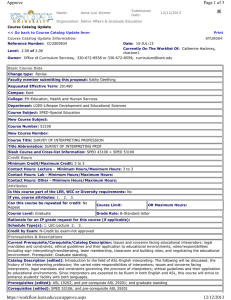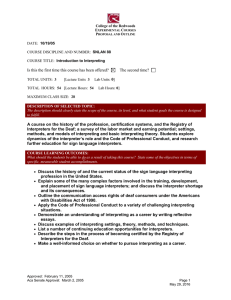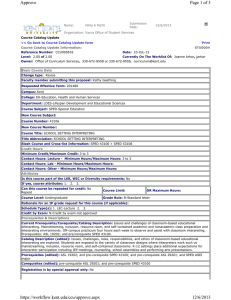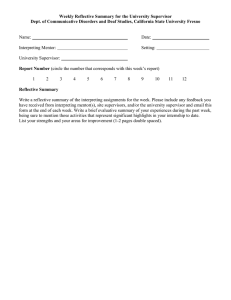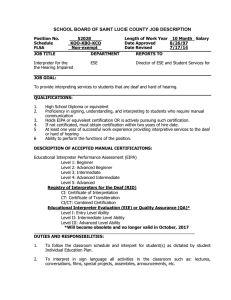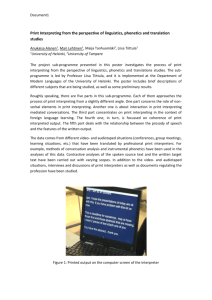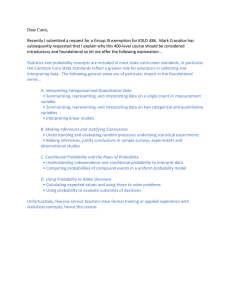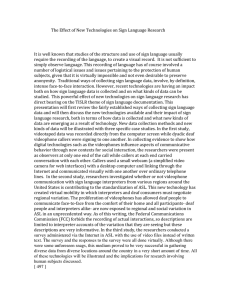of Submission Name:
advertisement
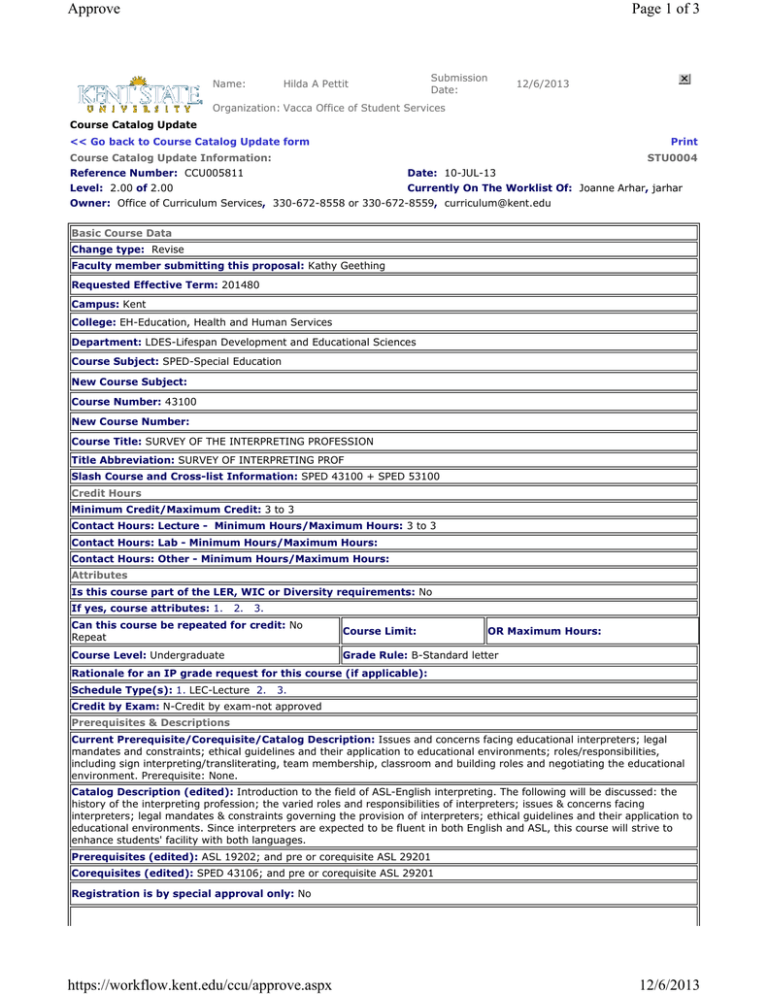
Approve Page 1 of 3 Name: Submission Date: Hilda A Pettit 12/6/2013 Organization: Vacca Office of Student Services Course Catalog Update << Go back to Course Catalog Update form Print Course Catalog Update Information: STU0004 Reference Number: CCU005811 Date: 10-JUL-13 Level: 2.00 of 2.00 Currently On The Worklist Of: Joanne Arhar, jarhar Owner: Office of Curriculum Services, 330-672-8558 or 330-672-8559, curriculum@kent.edu Basic Course Data Change type: Revise Faculty member submitting this proposal: Kathy Geething Requested Effective Term: 201480 Campus: Kent College: EH-Education, Health and Human Services Department: LDES-Lifespan Development and Educational Sciences Course Subject: SPED-Special Education New Course Subject: Course Number: 43100 New Course Number: Course Title: SURVEY OF THE INTERPRETING PROFESSION Title Abbreviation: SURVEY OF INTERPRETING PROF Slash Course and Cross-list Information: SPED 43100 + SPED 53100 Credit Hours Minimum Credit/Maximum Credit: 3 to 3 Contact Hours: Lecture - Minimum Hours/Maximum Hours: 3 to 3 Contact Hours: Lab - Minimum Hours/Maximum Hours: Contact Hours: Other - Minimum Hours/Maximum Hours: Attributes Is this course part of the LER, WIC or Diversity requirements: No If yes, course attributes: 1. 2. 3. Can this course be repeated for credit: No Repeat Course Limit: Course Level: Undergraduate Grade Rule: B-Standard letter OR Maximum Hours: Rationale for an IP grade request for this course (if applicable): Schedule Type(s): 1. LEC-Lecture 2. 3. Credit by Exam: N-Credit by exam-not approved Prerequisites & Descriptions Current Prerequisite/Corequisite/Catalog Description: Issues and concerns facing educational interpreters; legal mandates and constraints; ethical guidelines and their application to educational environments; roles/responsibilities, including sign interpreting/transliterating, team membership, classroom and building roles and negotiating the educational environment. Prerequisite: None. Catalog Description (edited): Introduction to the field of ASL-English interpreting. The following will be discussed: the history of the interpreting profession; the varied roles and responsibilities of interpreters; issues & concerns facing interpreters; legal mandates & constraints governing the provision of interpreters; ethical guidelines and their application to educational environments. Since interpreters are expected to be fluent in both English and ASL, this course will strive to enhance students' facility with both languages. Prerequisites (edited): ASL 19202; and pre or corequisite ASL 29201 Corequisites (edited): SPED 43106; and pre or corequisite ASL 29201 Registration is by special approval only: No https://workflow.kent.edu/ccu/approve.aspx 12/6/2013 Approve Page 2 of 3 Content Information Content Outline: Content Hours per Course Topic 6 6 6 3 3 6 3 3 3 3 3 Topic Description Mainstream American Culture vs. the culture of the Deaf Community; individualist vs. collectivist cultures; working with different cultures among the Deaf cultures (African American, Native Americans, Hispanic) Communication (the cycle; indirect and direct speech; powerful and powerless speech; passive voice; introductions, greetings, leave-taking) The history of interpreting; legislation; models of interpreting; RID and AVLIC; certifications Signaling (attention-getting; devices; eye contact; touch) Oppression and power of interpreters (stereotyping, audism, jokes) Identity and the Deaf community (Deaf, deaf, hard of hearing, hearing impaired, oral, contact varieties) The process of interpreting (A,B, and C languages; source and target languages; processing time; interpretation vs. transliteration vs. translation; consecutive vs. simultaneous interpreting; interpreting process models; dynamic equivalence) Prosody; dropping form; expansion and compression techniques; explicit and implicit meaning Register (frozen, formal, consultative, casual informal, intimate) Where interpreters work (education, employment, religious, medical, legal, mental health, performing arts, social services, video relay, persona settings) Team interpreting and CDIs Display/Hide Delimited Course Outline Total Contact Hours: 45 Textbook(s) used in this course: Humphrey, J., & Alcorn, A. So, you want to be an Interpreter? An Introduction to Sign Language Interpreting, Textbook with CD Study Guide by Renton, WA: H & H Publishing Co. Writing Expectations: Reaction paper or research paper. Graduate students will be given 2 additional vocabulary quizzes and will write an additional paper on deafness. Instructor(s) expected to teach: SPED Staff Instructor(s) contributing to content: Pam Luft Proposal Summary Explain the purpose for this proposal: The purpose of this proposal is to update the prerequisites, corequisites, content outline, course description, writing expectations, instructor information, and textbook used in order to keep the course current with the field. Within the KSU ASL English Interpreting Program, this is a basic course designed to give students a smattering of information dealing with Deaf people, interpreters, and the interpreting process. 1) Identify basic differences between Deaf people and those who can hear. Students will appreciate the value of eyes and hands to Deaf people. They will learn that Deaf people and those who can hear identify themselves differently and this will impact how they communicate with others. They will understand how and when English and ASL uses direct and indirect speech. 2) Identify differences between mainstream American culture and Deaf culture. They will realize that mainstream culture is not the same as a minority which causes individuals to have different beliefs and values. 3) Be familiar with the communication cycle. They will be able to state the interpreting process and define terms that are germane to this profession (processing time; interpretation, transliteration, translation; prosody, dropping form; dynamic equivalence; consecutive and simultaneous interpreting) 4) Differentiate among introductions, greeting, and leave-taking in American and Deaf cultures. Student will learn about attention-getting devices and methods. 4) Discuss the historical roots of interpreting. These roots include legislation; models of interpreting; the https://workflow.kent.edu/ccu/approve.aspx 12/6/2013 Approve Page 3 of 3 establishment of RID and AVLIC; certifications; and oppression and power struggles. 5) Describe interpreter’s role and responsibilities in various settings in which they may work. 6) Evaluate team interpreting with hearing and Deaf team members. 7) Demonstrate college level research and writing skills. Students need to be able to read scholarly articles and synthesize information from them. In this course, students will read for content and participate in class discussions and application assignments. Explain how this proposal affects program requirements and students in your unit: No effect. Explain how this proposal affects courses, program requirements and student in other units: No effect. Explain how this proposal affects enrollment and staffing: No effect. Units consulted (other departments, programs or campuses affected by the proposal): None. Revisions made to form (if applicable): Course Content Number Credit by Exam Prerequisites Credit Hours Schedule Type Cross-Listed / Slash Subject Description Title Diversity Title Abbreviation Grade Rule Writing-Intensive (WIC) Liberal Education Requirement (LER) Other Comments (500 Character Maximum): NOTE: Please do not use the following restricted characters: (~ * / \ --) Approve Comments: Date User 12/5/2013 Susan M Augustine Return To Initiator Return To Prior Approver Deny Comment Other Revisions: weekly contact hours, writing expectations, textbook and instructor information. History: Date User Status 12/5/2013 Susan M Augustine Approved 7/29/2013 Stacey M Dickman Submitted https://workflow.kent.edu/ccu/approve.aspx 12/6/2013
